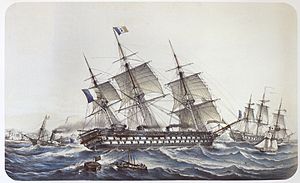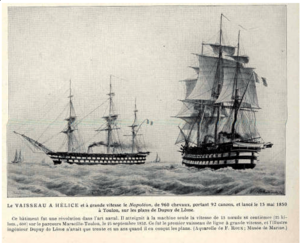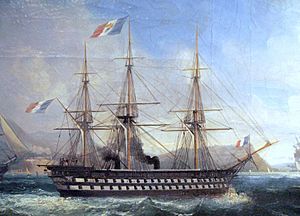French ship Napoléon (1850) facts for kids

Napoléon (1850), the first purpose-built steam battleship in history.
|
|
Quick facts for kids History |
|
|---|---|
| Name | Napoléon |
| Namesake | Napoléon I of France |
| Ordered | 14 July 1847 |
| Builder | Toulon |
| Laid down | 7 February 1848 |
| Launched | 16 May 1850 |
| Commissioned | 1 May 1852 |
| Stricken | 6 November 1876 |
| Fate | Broken up 1886 |
| General characteristics | |
| Class and type | Napoléon-class ship of the line |
| Displacement | 5,120 tonnes |
| Length | 77.8 m (255 ft 3 in) |
| Beam | 17 m (55 ft 9 in) |
| Draught | 8.4 m (27 ft 7 in) |
| Propulsion | Sail and 2-cyl Indret geared, 960 nhp (574 ihp) |
| Speed | 12.1 knots (22.4 km/h; 13.9 mph) |
| Endurance |
|
| Complement | 910 men |
| Armament |
|
The Napoléon was a very important warship in the French Navy. It was the world's first battleship built specifically to use a steam engine and a propeller. This made it a true steam battleship, unlike earlier ships that were just converted.
Launched in 1850, the Napoléon was the first of nine similar battleships. These ships were designed by a famous naval engineer named Henri Dupuy de Lôme. The ship was first going to be named Prince de Joinville. But during a time of political change in France, it was renamed 24 Février. This celebrated the end of King Louis Philippe I's rule. A few days after its launch in May 1850, it was finally named Napoléon. The ship was taken apart in 1886.
Why Steam Power Was a Big Deal
Before the 1840s, most warships used sails. Some ships tried using steam engines with large side paddle wheels. But these paddle wheels took up too much space. They also got in the way of the cannons placed along the ship's sides. This made them not work well for big battleships.
Then, a new idea came along: the propeller, or "screw." This was a much better way to use steam power on warships. The propeller was placed at the back of the ship, under the water. This meant it didn't interfere with the cannons.
The designer, Henri Dupuy de Lôme, was very brave to create a full-powered steam battleship. The Napoléon was ordered in 1847. Its success showed that all navies would need to start building steam-powered ships.
The Napoléon was launched in 1850 and tested in 1852. It could travel at almost 14 knots (about 26 kilometers per hour). During the Crimean War, its performance was very impressive. This led to many more ships like it being built. The Napoléon was about 77.8 meters (240 feet) long and 17 meters (55 feet) wide. It weighed about 5,000 tons and had two decks for cannons. Its design was both bold and smart. It kept the good qualities of older sailing battleships while adding the new steam power and enough space for coal.
Around 1844–1845, the friendly relationship between Britain and France began to weaken. This was because France got involved in places like Tahiti and Morocco. Also, French writers started saying that France needed a stronger navy. This led to a competition between the two countries to build more powerful warships.
Britain already had some smaller steam-powered ships in the 1840s. These were called "blockships." They were older battleships that had been changed to use steam engines. They could go between 5.8 and 8.9 knots. The British Royal Navy also built steam-powered sloops (smaller warships). The HMS Rattler was the first screw-propelled warship launched anywhere in the world in 1843.
Both France and Britain also developed steam frigates (medium-sized warships). The French ship Pomone was launched in 1845. The British Amphion followed a year later. But the Napoléon was the first full-sized steam battleship to be launched.
In 1847, Britain designed a screw/steam battleship called James Watt. But this project was delayed. It did not enter service until 1854. Its sister ship, Agamemnon, was ordered in 1849 and started service in 1853. Another sailing battleship, Sans Pareil, was changed to steam while it was being built. It was launched in 1851 and started service even before Agamemnon.
Britain was slow to fully commit to steam battleships. This was because their navy operated all over the world. For long journeys, sails were still the most reliable way to travel at that time.
In the end, France and Great Britain were the only two countries that built large fleets of wooden steam battleships. Other navies, like those of Russia and the Ottoman Empire, had at least one steam ship. These often got technical help from Britain. Overall, France built 10 new wooden steam battleships and changed 28 older ones. Britain built 18 new ones and changed 41 older ships.
Images for kids
-
Napoléon at the 1852 naval review in Toulon.





